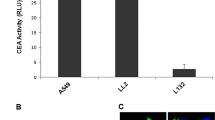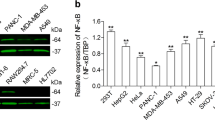Abstract
Cervical cancers at advanced stages or with recurrent status are mainly treated by platinum-based chemotherapy, such as cisplatin. However, a novel strategy to reduce the minimally effective dose is required to prevent severe adverse effects that limit the effectiveness of the treatment. Monocyte chemoattractant protein-1 (MCP-1) is a subtype of chemokines that can promote monocyte/macrophage infiltration and enhance their phagocytosis at not only sites of inflammatory lesions but also of tumors. The present study applies MCP-1-based gene therapy to treat cervical cancers. To achieve tumor-specific expression of MCP-1, retroviral expression vector was constructed using the human telomerase reverse transcriptase gene (hTERT) promoter. Retroviral expression of MCP-1 into cervical cancer ME180 cells did not affect their proliferation either in vitro or in vivo. However, when combined with a suboptimal low dose of cisplatin, tumor formation was obviously reduced in clones transduced with MCP-1, but not in control clones. Histological examination revealed that a substantial number of macrophages infiltrated the tumor sites of MCP-1-transduced cells, but not of controls. These findings suggest that MCP-1 expression sensitizes cervical cancer cells to an otherwise ineffective low dose of cisplatin, possibly by inducing the migration of macrophages to eradicate tumor cells. This system may be a novel strategy for chemotherapy combined with immunogene therapy against otherwise intractable cervical cancers.
This is a preview of subscription content, access via your institution
Access options
Subscribe to this journal
Receive 12 print issues and online access
$259.00 per year
only $21.58 per issue
Buy this article
- Purchase on Springer Link
- Instant access to full article PDF
Prices may be subject to local taxes which are calculated during checkout






Similar content being viewed by others
References
Morris M, Eifel PJ, Lu J, et al. Pelvic radiation with concurrent chemotherapy compared with pelvic and para-aortic radiation for high-risk cervical cancer. N Eng J Med. 1999;340:1137–1143.
Rose PG, Bundy BN, Watkins EB, et al. Concurrent cisplatin-based radiotherapy and chemotherapy for locally advanced cervical cancer. N Eng J Med. 1999;340:1144–1153.
Keys HM, Bundy BN, Stehman FB, et al. Cisplatin, radiation, and adjuvant hysterectomy compare with radiation and adjuvant hysterectomy for bulky stage IB cervical carcinoma. N Eng J Med. 1999;340:1154–1161.
Zagozdzon R, Golab J . Immunomodulation by anticancer chemotherapy: more is not always better [Review]. Int J Oncol. 2001;18:417–424.
Matsushima K, Larsen CG, DuBois GC, Oppenheim JJ . Purification and characterization of a novel monocyte chemotactic and activating factor produced by a human myelomonocytic cell line. J Exp Med. 1989;169:1485–1490.
Furutani Y, Nomura H, Notake M, et al. Cloning and sequencing of the cDNA for human monocyte chemotactic and activating factor (MCAF). Biochem Biophys Res Commun. 1989;159:249–255.
Rollins BJ, Sunday ME . Suppression of tumor formation in vivo by expression of the JE gene in malignant cells. Mol Cell Biol. 1991;11:3125–3131.
Nokihara H, Yanagawa H, Nishioka Y, et al. Natural killer cell-dependent suppression of systemic spread of human lung adenocarcinoma cells by monocyte chemoattractant protein-1 gene transfection in severe combined immunodeficient mice. Cancer Res. 2000;60:7002–7007.
Greider CW, Blackburn EH . A telomeric sequence in the RNA of Tetrahymena telomerase required for telomerase repeat synthesis. Nature. 1989;337:331–337.
Harley CB, Futcher BA, Greider CW . Telomerase shorten during ageing of human fibroblasts. Nature. 1990;345:458–460.
Kim NW, Piatyszek MA, Prowse KR, et al. Specific association of human telomerase activity with immortal cells and cancer. Science. 1994;266:2011–2015.
Meyerson M, Counter CM, Eaton EN, et al. HEST2, the putative human telomerase catalytic subunit gene, is up-regulated in tumor cells and during immortalization. Cell. 1997;90:785–795.
Nakamura TM, Morin GB, Chapman KB, et al. Telomerase catalytic subunit homologs from fission yeast and human. Science. 1997;277:955–959.
Takakura M, Kyo S, Kanaya T, et al. Cloning of human telomerase catalytic subunit (hTERT) gene promoter and identification of proximal core promoter sequences essential for transcriptional activation in immortalized and cancer cells. Cancer Res. 1999;59:551–557.
Cong YS, Wen J, Bacchetti S . The human telomerase catalytic subunit hTERT: organization of the gene and characterization of the promoter. Hum Mol Genet. 1999;8:137–142.
Horikawa I, Cable PL, Afshari C, et al. Cloning and characterization of the promoter region of human telomerase reverse transcriptase gene. Cancer Res. 1999;59:826–830.
Kyo S, Takakura M, Taira T, et al. Sp 1 cooperates with c-Myc to activate transcription of the human telomerase reverse transcriptase gene (hTERT). Nucleic Acids Res. 2000;28:669–677.
Kyo S, Inoue M . Complex regulatory mechanisms of telomerase activity in normal and cancer cells: how can we apply them for cancer therapy. Oncogene. 2002;21:688–697.
Gu J, Kagawa S, Takakura M, et al. Tumor-specific transgene expression from the human telomerase reverse transcriptase promoter enable targeting of the therapeutic effects of the Bax gene to cancers. Cancer Res. 2000;60:5359–5364.
Wada T, Furuichi K, Segawa-Takaeda C, et al. MIP-1 alpha and MCP-1 contribute to crescents and interstitial lesions in human crescentic glomerulonephritis. Kidney Int. 1999;56:995–1003.
Ozawa K, Kondo T, Hori O, et al. Expression of the oxygen-regulated protein ORP150 accelerates wound healing by modulating intracellular VEGF transport. J Clin Invest. 2001;108:41–50.
Kondo Y, Komata T, Kondo S . Combination therapy of 2-5A antisense against telomerse RNA and cisplatin for malignant gliomas. Int J Oncol. 2001;18:1287–1292.
Bottazzi B, Walter S, Govoni D, et al. Monocyte chemotactic cytokine gene transfer modulates macrophage infiltration, growth, and susceptibility to IL-2 therapy of a murine melanoma. J Immunol. 1992;148:1280–1285.
Singh RK, Berry K, Matsushima K, et al. Synergism between human monocyte chemotactic and activating factor and bacterial products for activation of tumoricidal properties in murine macrophages. J Immunol. 1993;151:2786–2793.
Huang S, Singh RK, Xie K, et al. Expression of the JE/MCP-1 gene suppresses metastatic potential in murine colon carcinoma cells. Cancer Immunol Immnother. 1994;39:231–238.
Huang S, Xie K, Singh RK, et al. Suppression of tumor growth and metastasis of murine renal adenocarcinoma by syngeneic fibroblasts genetically engineered to secrete the JE/MCP-1 cytokine. J Interferon Cytokine Res. 1995;15:655–665.
Nishioka Y, Yano S, Fujiki F, et al. Combined therapy of multidrug-resistant human lung cancer with anti-P-glycoprotein antibody and monocyte chemoattractant protein-1 gene transduction: the possibility of immunological overcoming of multidrug resistance. Int J Cancer. 1997;71:170–177.
Nokihara H, Nishioka Y, Yano S, et al. Monocyte chemoattractant protein-1 gene modification of multidrug-resistant human lung cancer enhances antimetastatic effect of therapy with anti-P-glycoprotein antibody in SCID mice. Int J Cancer. 1999;80:773–780.
Sakai Y, Kaneko S, Nakamoto Y, et al. Enhanced anti-tumor effects of herpes simplex virus thymidine kinase/ganciclovir system by codelivering monocyte chemoattractant protein-1 in hepatocellular carcinoma. Cancer Gene Ther. 2001;8:695–704.
Garzetti GG, Ciavattini A, Provinciali M, et al. Expression of p53 and apoptosis of tumor cells in locally advanced cervical carcinoma after cisplatin based neoadjuvant chemotherapy. Anticancer Res. 1996;16:3229–3234.
Kaneko S, Hallenbeck P, Kotani T, et al. Adenovirus-mediated gene therapy of hepatocellular carcinoma using cancer-specific gene expression. Cancer Res. 1995;55:5283–5287.
Yu D, Chen D, Chiu C, et al. Prostate-specific targeting using PSA promoter-based lentiviral vectors. Cancer Gene Ther. 2001;8:628–635.
Author information
Authors and Affiliations
Corresponding author
Rights and permissions
About this article
Cite this article
Nakamura, M., Kyo, S., Kanaya, T. et al. hTERT-promoter-based tumor-specific expression of MCP-1 effectively sensitizes cervical cancer cells to a low dose of cisplatin. Cancer Gene Ther 11, 1–7 (2004). https://doi.org/10.1038/sj.cgt.7700650
Received:
Published:
Issue Date:
DOI: https://doi.org/10.1038/sj.cgt.7700650



